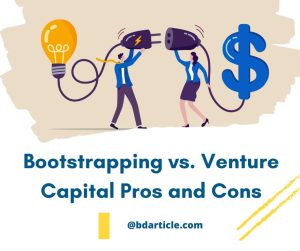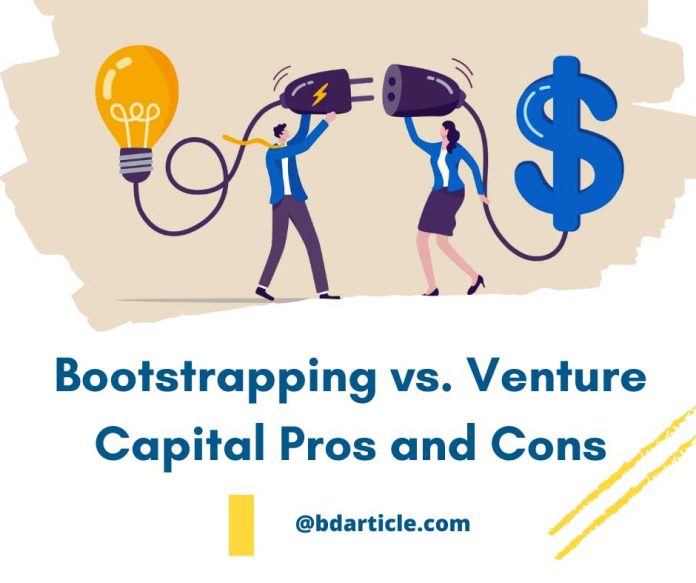When launching a business, choosing the right funding strategy is a pivotal decision to shape its growth and future. Entrepreneurs often weigh two popular options: bootstrapping, using personal savings and reinvested profits, or seeking Venture Capital Pros (VC) funding from investors in exchange for equity.
The debate between bootstrap vs VC funding centers around critical factors such as control, growth speed, and financial risk. Bootstrapping offers independence and full ownership but may limit resources, while venture capital accelerates growth with substantial funding but involves equity dilution and external oversight. Each approach has unique advantages and challenges, making it essential to align the funding choice with your business goals and industry dynamics. This article explores the pros and cons of both strategies, empowering you to decide which path suits your entrepreneurial journey and vision for success.

What Is Bootstrapping?
Bootstrapping is a funding approach where entrepreneurs build their businesses using personal resources instead of external investments. Founders rely on their savings, reinvest profits, or sometimes seek financial help from friends and family. This self-sufficient strategy appeals to those who value independence and full control over their company’s decisions. By bootstrapping, entrepreneurs retain complete ownership and are not subject to investor pressures, allowing them to prioritize long-term growth over short-term returns. However, it often comes with challenges like limited resources and slower scaling opportunities.
What Is Venture Capital (VC) Funding?
Venture capital is a form of financing where investors provide significant funds to startups in exchange for equity. This funding model is particularly attractive to businesses aiming for rapid expansion, as it offers substantial resources, mentorship, and networking opportunities. Startups can use VC funding to scale operations, develop products, or hire skilled talent. While VC funding accelerates growth, it also involves relinquishing some control and equity to investors, often accompanied by high expectations for swift returns.
Advantages of Bootstrapping
-
Full Control Over Decisions
One of the biggest advantages of bootstrapping is retaining complete ownership and control. Founders can make decisions without external interference, preserving their vision and values.
-
Minimal Financial Pressure
Unlike VC-backed startups, bootstrapped companies are not pressured to deliver exponential growth or immediate returns. This allows founders to focus on sustainable business practices.
-
Ownership Equity
Bootstrapping enables founders to keep all the equity, ensuring that long-term profits belong solely to them. “Co-founder Equity Split Guidelines Made Easy” is particularly relevant in this context, emphasizing equitable ownership distribution among partners.
-
Strong Customer Focus
Since bootstrapped startups rely on early customer revenue, they are often more customer-centric. Founders prioritize delivering value, which can lead to stronger brand loyalty.
Challenges of Bootstrapping
Bootstrapping empowers entrepreneurs who value independence, but it comes with notable challenges that can impact a startup’s trajectory.
-
Limited Resources
Bootstrapping often strains personal finances, as founders rely heavily on their savings or small-scale loans. This limits the company’s ability to invest in vital growth areas such as advanced technology, marketing, or hiring top-tier talent. The lack of substantial funding can delay scaling operations and restrict the business’s competitive edge.
-
Slower Growth
Achieving rapid expansion without external capital is inherently difficult. Bootstrapped startups may struggle to seize market opportunities, allowing competitors with venture capital backing to outpace them regarding market share, product development, or brand presence.
-
Personal Risk
Using personal savings or borrowing from friends and family brings significant financial risks. If the business fails, founders face the burden of lost investments and potentially strained relationships. This high personal accountability makes bootstrapping a double-edged sword, demanding calculated risks and meticulous financial management.
Advantages of Venture Capital
Venture capital (VC) funding is a powerful catalyst for startups seeking rapid growth and market dominance. Its benefits extend beyond financial resources, offering startups strategic advantages that are hard to replicate through other funding methods.
-
Access to Large Funds
One of the primary advantages of VC funding is the infusion of substantial capital. Startups can use these resources to scale operations, enter new markets, or develop innovative products and services. With this financial backing, companies can outpace competitors by investing in advanced technology and skilled talent.
-
Strategic Mentorship and Networking
Venture capitalists often provide more than funding; they bring industry expertise, guidance, and valuable connections. This mentorship helps founders tackle challenges and identify growth opportunities. Access to a VC’s network can open doors to key partnerships, customers, and resources.
-
Enhanced Credibility
Securing VC funding enhances a startup’s reputation, making it more appealing to top talent, strategic partners, and customers. Programs like AWS Venture Capital and Amazon Startup Funding highlight the benefits of VC partnerships, combining financial support with operational expertise.
-
Risk Sharing
Venture capital mitigates personal financial risk for founders. With external investors sharing the burden, entrepreneurs can focus on innovation and execution, fostering long-term success.
Challenges of Venture Capital
While venture capital (VC) funding offers significant financial and strategic advantages, it also comes with challenges that can affect a startup’s direction and founder autonomy. These factors must be carefully considered before pursuing VC investment.
-
Loss of Control
Venture capitalists typically demand equity in exchange for their investment, often coupled with a say in major business decisions. This shared control can lead to conflicts, particularly when the investors’ priorities differ from the founder’s vision. Founders may compromise on their original goals to align with investor expectations.
-
High Expectations
VC-backed startups are constantly pressured to deliver quick and substantial returns. This relentless focus on rapid growth can sometimes force businesses to prioritize short-term gains over long-term sustainability, potentially jeopardizing the company’s future stability.
-
Dilution of Ownership
With every new round of funding, founders surrender a portion of their equity. Over time, this dilution can significantly reduce the founder’s ownership stake, limiting their ability to influence critical decisions and profit from the company’s success.
-
Complex Processes
Securing VC funding involves extensive effort, including crafting detailed pitch decks, undergoing rigorous due diligence, and negotiating terms. These processes can consume valuable time and energy, diverting focus from core business operations.
Key Factors to Consider: Bootstrapping vs. Venture Capital
-
Business Goals and Vision
Ask yourself: Do you want to grow your business gradually or scale rapidly? Bootstrapping may be ideal if your vision aligns with sustainable growth and independence. If scaling quickly to dominate a market is your priority, venture capital is worth exploring.
-
Industry and Market Dynamics
Certain industries, such as tech or biotech, require significant upfront investment. In such cases, VC funding might be essential to compete effectively.
-
Ownership Priorities
If maintaining full ownership is non-negotiable, bootstrapping is the way to go. On the other hand, venture capital can be highly rewarding if you are open to sharing equity in exchange for strategic advantages.
Real-Life Examples: Bootstrapping and VC Success Stories
Bootstrapping Success: Mailchimp is a prime example of a bootstrapped startup that achieved remarkable success. Mailchimp became a market leader in email marketing without external funding by focusing on customer needs and reinvesting profits.
VC-Funded Success: Slack, a productivity software company, leveraged venture capital to achieve rapid growth and market penetration. With access to funds and strategic advice, Slack disrupted the workplace communication industry.
The Role of AWS Venture Capital and Amazon Startup Funding
Programs like AWS Venture Capital and Amazon Startup Funding provide unique startup opportunities. They combine financial investment with access to cloud infrastructure, tools, and mentorship, making them an attractive option for tech-focused startups.
AWS’s scalability and flexibility enable VC-backed startups to optimize operations and drive innovation, while bootstrapped businesses benefit from cost-effective solutions tailored to smaller budgets.
Bootstrapping vs. Fundraising: Which Is Right for You?
While both options have merit, your decision should depend on your business model, goals, and personal preferences.
- If you prioritize independence and customer focus, bootstrapping offers long-term rewards.
- Venture capital can accelerate your journey if you seek rapid growth and market dominance.
Balancing the two approaches is also possible. Some startups begin by bootstrapping and later seek VC funding once they achieve a stable foundation.
Final Thoughts
Choosing between bootstrapping and venture capital funding is a highly personal decision, influenced by your business goals, risk appetite, and vision for growth. Bootstrapping offers independence and full control, fostering sustainable growth, while VC funding provides the resources and mentorship needed for rapid scaling. Neither approach is inherently better; the right choice depends on your unique circumstances and aspirations. Evaluate your priorities carefully, considering ownership, growth pace, and financial risk. Regardless of your path, bootstrapping and VC funding offer valuable opportunities to learn, grow, and achieve entrepreneurial success.
#Bootstrapping_vs_VC_funding #Venture_Capital_Funding_Advantages #Bootstrapping_Challenges

